An Integrative Approach to the Flavonoid Profile in Some Plants’ Parts of the Annona Genus
Abstract
1. Introduction
2. Results and Discussion
3. Materials and Methods
4. Conclusions
Author Contributions
Funding
Institutional Review Board Statement
Informed Consent Statement
Data Availability Statement
Acknowledgments
Conflicts of Interest
References
- Barosa, L.T.C.; Vega, M.R.G. Diterpenos Do Gênero Xylopia. Rev. Virtual Quim. 2017, 9, 1712–1733. [Google Scholar]
- Attiq, A.; Jalil, J.; Husain, K. Annonaceae: Breaking the Wall of Inflammation. Front. Pharmacol. 2017, 8, 752. [Google Scholar] [CrossRef] [PubMed]
- Hamonnière, M.; Leboeuf, M.; Cavé, A. Alcaloides Aporphiniques et Composés Terpéniques Du Polyalthia Oliveri. Phytochemistry 1977, 16, 1029–1034. [Google Scholar] [CrossRef]
- Cercato, L.M.; White, P.A.S.; Nampo, F.K.; Santos, M.R.V.; Camargo, E.A. A Systematic Review of Medicinal Plants Used for Weight Loss in Brazil: Is There Potential for Obesity Treatment? J. Ethnopharmacol. 2015, 176, 286–296. [Google Scholar] [CrossRef]
- Bhalk, R.D.; Chavan, M.J. Analgesic and CNS Depressant Activities of Extracts of Annona Reticulata Linn. Bark. Phytopharmacology 2011, 1, 160–165. [Google Scholar]
- González-Esquinca, A.R.; De-La-Cruz-Chacón, I.; Castro-Moreno, M.; Orozco-Castillo, J.A.; Riley- Saldaña, C.A. Alkaloids and Acetogenins in Annonaceae Development: Biological Considerations. Rev. Bras. Frutic. 2014, 36, 1–16. [Google Scholar] [CrossRef]
- Moghadamtousi, S.; Fadaeinasab, M.; Nikzad, S.; Mohan, G.; Ali, H.; Kadir, H. Annona Muricata (Annonaceae): A Review of Its Traditional Uses, Isolated Acetogenins and Biological Activities. Int. J. Mol. Sci. 2015, 16, 15625–15658. [Google Scholar] [CrossRef]
- Brito, H.O.; Noronha, E.P.; França, L.M.; Brito, L.M.O.; Prado, M.S.-A. Análise Da Composição Fitoquímica Do Extrato Etanólico Das Folhas Da Annona Squamosa (ATA). Rev. Bras. Farm. 2008, 89, 180–184. [Google Scholar]
- Chokchaisiri, R.; Chaichompoo, W.; Chalermglin, R.; Suksamrarn, A. Potent Antiplasmodial Alkaloids and Flavonoids from Dasymaschalon Acuminatum. Rec. Nat. Prod. 2015, 9, 243–246. [Google Scholar]
- Chang, F.-R.; Yang, P.-Y.; Lin, J.-Y.; Lee, K.-H.; Wu, Y.-C. Bioactive Kaurane Diterpenoids from Annona Glabra. J. Nat. Prod. 1998, 61, 437–439. [Google Scholar] [CrossRef]
- Rabelo, S.V.; Quintans, J.d.S.S.; Costa, E.V.; Almeida, J.R.G.d.S.; Júnior, L.J.Q. Annona Species (Annonaceae) Oils. In Essential Oils in Food Preservation, Flavor and Safety; Elsevier: Amsterdam, The Netherlands, 2016; pp. 221–229. [Google Scholar]
- Ferreira, L.; Perestrelo, R.; Camara, J. Comparative Analysis of the Volatile Fraction from Annona Cherimola Mill. Cultivars by Solid-Phase Microextraction and Gas Chromatography–Quadrupole Mass Spectrometry Detection. Talanta 2009, 77, 1087–1096. [Google Scholar] [CrossRef] [PubMed]
- Rayanil, K.; Sutassanawichanna, W.; Suntornwat, O.; Tuntiwachwuttikul, P. A New Dihydrobenzofuran Lignan and Potential α -Glucosidase Inhibitory Activity of Isolated Compounds from Mitrephora Teysmannii. Nat. Prod. Res. 2016, 30, 2675–2681. [Google Scholar] [CrossRef] [PubMed]
- Moreira, I.C.; Lago, J.H.G.; Roque, N.F. Alkaloid, Flavonoids and Terpenoids from Leaves and Fruits of Xylopia Emarginata (Annonaceae). Biochem. Syst. Ecol. 2003, 31, 535–537. [Google Scholar] [CrossRef]
- da Silva, D.B.; Matos, M.d.F.C.; Nakashita, S.T.; Misu, C.K.; Yoshida, N.C.; Carollo, C.A.; Fabri, J.R.; Miglio, H.d.S.; Siqueira, J.M. de Isolamento e Avaliação Da Atividade Citotóxica de Alguns Alcalóides Oxaporfínicos Obtidos de Annonaceae. Quim. Nova 2007, 30, 1809–1812. [Google Scholar] [CrossRef]
- Soares, E.R.; da Silva, F.M.A.; de Almeida, R.A.; de Lima, B.R.; Filho, F.A.d.S.; Barison, A.; Koolen, H.H.F.; Pinheiro, M.L.B.; de Souza, A.D.L. Direct Infusion ESI-IT-MSn Alkaloid Profile and Isolation of Tetrahydroharman and Other Alkaloids from Bocageopsis Pleiosperma Maas (Annonaceae). Phytochem. Anal. 2015, 26, 339–345. [Google Scholar] [CrossRef]
- Alali, F.Q.; Liu, X.-X.; McLaughlin, J.L. Annonaceous Acetogenins: Recent Progress. J. Nat. Prod. 1999, 62, 504–540. [Google Scholar] [CrossRef]
- Bermejo, A.; Figadère, B.; Zafra-Polo, M.-C.; Barrachina, I.; Estornell, E.; Cortes, D. Acetogenins from Annonaceae: Recent Progress in Isolation, Synthesis and Mechanisms of Action. Nat. Prod. Rep. 2005, 22, 269–303. [Google Scholar] [CrossRef]
- Krinski, D.; Massaroli, A.; Machado, M. Potencial Inseticida de Plantas Da Família Annonaceae. Rev. Bras. Frutic. 2014, 36, 225–242. [Google Scholar] [CrossRef]
- De Melo, A.P.C.; Seleguini, A.; Leite, A.F.; De Souza, E.R.B.; Naves, R.V. Fenologia Reprodutiva Do Araticum e Suas Implicações No Potencial Produtivo. Comun. Sci. 2015, 6, 495. [Google Scholar] [CrossRef]
- Rocha, G.N.d.S.A.O.; Dutra, L.M.; Lorenzo, V.P.; Almeida, J.R.G.d.S. Phytochemicals and Biological Properties of Annona Coriacea Mart. (Annonaceae): A Systematic Review from 1971 to 2020. Chem. Biol. Interact. 2021, 336, 109390. [Google Scholar] [CrossRef]
- Brito, M.T.; Ferreira, R.C.; Beltrão, D.M.; Moura, A.P.G.; Xavier, A.L.; Pita, J.C.L.R.; Batista, T.M.; Longato, G.B.; Ruiz, A.L.T.G.; de Carvalho, J.E.; et al. Antitumor Activity and Toxicity of Volatile Oil from the Leaves of Annona Leptopetala. Rev. Bras. Farmacogn. 2018, 28, 602–609. [Google Scholar] [CrossRef]
- Pimenta, A.C.; Silva, P.S.d.R.; Zuffellato-Ribas, K.C.; Koehler, H.S. Caracterização de Plantas e de Frutos de Araticunzeiro (Annona Crassiflora Mart.) Nativos No Cerrado Matogrossense. Rev. Bras. Frutic. 2014, 36, 892–899. [Google Scholar] [CrossRef]
- Arruda, H.S.; Pastore, G.M. Araticum (Annona Crassiflora Mart.) as a Source of Nutrients and Bioactive Compounds for Food and Non-Food Purposes: A Comprehensive Review. Food Res. Int. 2019, 123, 450–480. [Google Scholar] [CrossRef]
- Cardoso, L.; de Araticum, M.; Jatobá, C. Mangaba e Pequi Do Cerrado de Minas Gerais: Ocorrência e Conteúdo de Carotenóides e Vitaminas; Universidade Federal de Viçosa: Viçosa, Brazil, 2011. [Google Scholar]
- Arruda, H.S.; Pereira, G.A.; de Morais, D.R.; Eberlin, M.N.; Pastore, G.M. Determination of Free, Esterified, Glycosylated and Insoluble-Bound Phenolics Composition in the Edible Part of Araticum Fruit (Annona Crassiflora Mart.) and Its by-Products by HPLC-ESI-MS/MS. Food Chem. 2018, 245, 738–749. [Google Scholar] [CrossRef]
- Arruda, H.S.; Fernandes, R.V.d.B.; Botrel, D.A.; Almeida, M.E.F. Frutos Do Cerrado: Conhecimento e Aceitação de Annona Crassiflora Mart. (Araticum) e Eugenia Dysenterica Mart. (Cagaita) Por Crianças Utilizando o Paladar e a Visão. J. Health Biol. Sci. 2015, 3, 224. [Google Scholar] [CrossRef][Green Version]
- de Morais, E.C.; Patias, S.G.d.O.; Ferreira, N.S.d.S.; Picanço, N.F.M.; Rodrigues, E.C.; Nascimento, E.; Faria, R.A.P.G. e Compostos Bioativos e Características Físico-Químicas de Polpa de Araticum in Natura e Pasteurizada. Braz. J. Food Technol. 2017, 20, e2016142. [Google Scholar] [CrossRef][Green Version]
- Cardoso, L.d.M.; Oliveira, D.d.S.; Bedetti, S.d.F.; Martino, H.S.D.; Pinheiro-Sant’Ana, H.M. Araticum ( Annona Crassiflora Mart.) from the Brazilian Cerrado: Chemical Composition and Bioactive Compounds. Fruits 2013, 68, 121–134. [Google Scholar] [CrossRef]
- Reis, A.F.; Schmiele, M. Características e Potencialidades Dos Frutos Do Cerrado Na Indústria de Alimentos. Braz. J. Food Technol. 2019, 22, e2017150. [Google Scholar] [CrossRef]
- Lee, C.H.; Lee, T.H.; Ong, P.Y.; Wong, S.L.; Hamdan, N.; Elgharbawy, A.A.M.; Azmi, N.A. Integrated Ultrasound-Mechanical Stirrer Technique for Extraction of Total Alkaloid Content from Annona Muricata. Process Biochem. 2021, 109, 104–116. [Google Scholar] [CrossRef]
- Nolasco-González, Y.; Chacón-López, M.A.; Ortiz-Basurto, R.I.; Aguilera-Aguirre, S.; González-Aguilar, G.A.; Rodríguez-Aguayo, C.; Navarro-Cortez, M.C.; García-Galindo, H.S.; García-Magaña, M.d.L.; Meza-Espinoza, L.; et al. Annona Muricata Leaves as a Source of Bioactive Compounds: Extraction and Quantification Using Ultrasound. Horticulturae 2022, 8, 560. [Google Scholar] [CrossRef]
- Mishra, S.; Ahmad, S.; Kumar, N.; Sharma, B.K. Annona Muricata (the Cancer Killer): A Review. Glob. J. Pharm. Res. 2013, 2, 1613–1618. [Google Scholar]
- Pinto, A.C.d.Q.; Cordeiro, M.C.R.; de Andrade, S.R.M.; Ferreira, F.R.; Filgueiras, H.A.d.C.; Alves, R.E.; Kinpara, D.I. Annona Species, 1st ed.; Williams, J.T., Smith, R.W., Hughes, A., Haq, N., Clement, C.R., Eds.; International Centre for Underutilised Crops, University of Southampton: Southampton, UK, 2005; ISBN 0854327851. [Google Scholar]
- Chen, A.M.; Farwell, D.G.; Luu, Q.; Vazquez, E.G.; Lau, D.H.; Purdy, J.A. Intensity-Modulated Radiotherapy Is Associated with Improved Global Quality of Life among Long-Term Survivors of Head-and-Neck Cancer. Int. J. Radiat. Oncol. 2012, 84, 170–175. [Google Scholar] [CrossRef] [PubMed]
- Fuentes, L.M.H.; González, E.M.; Magaña, M.d.L.G.; Esparza, L.M.A.; González, Y.N.; Villagrán, Z.; Torres, S.G.; Monreal, J.J.V.; Flores, D.A.M. Current Situation and Perspectives of Fruit Annonaceae in Mexico: Biological and Agronomic Importance and Bioactive Properties. Plants 2021, 11, 7. [Google Scholar] [CrossRef] [PubMed]
- de Oliveira, M.C.; Ferreira, G.; Guimarães, V.F.; Dias, G.B. Germinação de Sementes de Atemoia (Annona Cherimola Mill. × A. Squamosa L.) Cv “Gefner” Submetidas a Tratamentos Com Ácido Giberélico (GA3) e Ethephon. Rev. Bras. Frutic. 2010, 32, 544–554. [Google Scholar] [CrossRef]
- dos Santos, W.N.L.; Sauthier, M.C.S.; Cavalcante, D.D.; Benevides, C.M.J.; Dias, F.S.; Santos, D.C.M.B. Mineral Composition, Nutritional Properties, Total Phenolics and Flavonoids Compounds of the Atemoya Fruit (Annona Squamosa L. × Annona Cherimola Mill.) and Evaluation Using Multivariate Analysis Techniques. An. Acad. Bras. Cienc. 2016, 88, 1243–1252. [Google Scholar] [CrossRef] [PubMed]
- Rabêlo, S.V. Revisão de Alcaloides Do Gênero Annona, Estudo Fitoquímico e Avaliação Da atividade Biológica de Atemoia (Annona Cherimolax Annona Squamosa); Universidade Federal do Vale do São Francisco: Petrolina, Brazil, 2014. [Google Scholar]
- Rabêlo, S.V.; Costa, E.V.; Barison, A.; Dutra, L.M.; Nunes, X.P.; Tomaz, J.C.; Oliveira, G.G.; Lopes, N.P.; Santos, M.d.F.C.; Almeida, J.R.G.d.S. Alkaloids Isolated from the Leaves of Atemoya (Annona Cherimola × Annona Squamosa). Rev. Bras. Farmacogn. 2015, 25, 419–421. [Google Scholar] [CrossRef]
- Fortuño, J.N. Guía de Las Frutas Cultivadas: Identificación y Cultivo, 1st ed.; Ediciones Mundi-Prensa: Madrid, Spain, 2001; ISBN 848476009X. [Google Scholar]
- Bataglion, G.A.; da Silva, F.M.A.; Eberlin, M.N.; Koolen, H.H.F. Determination of the Phenolic Composition from Brazilian Tropical Fruits by UHPLC–MS/MS. Food Chem. 2015, 180, 280–287. [Google Scholar] [CrossRef]
- Liu, K.; Li, H.; Yuan, C.; Huang, Y.; Chen, Y.; Liu, J. Identification of Phenological Growth Stages of Sugar Apple (Annona Squamosa L.) Using the Extended BBCH-Scale. Sci. Hortic. 2015, 181, 76–80. [Google Scholar] [CrossRef]
- CNFlora Annona Squamosa. Available online: http://cncflora.jbrj.gov.br/portal/pt-br/profile/Annona squamosa (accessed on 19 August 2022).
- de Lima, A.L.A.; Sampaio, E.V.d.S.B.; de Castro, C.C.; Rodal, M.J.N.; Antonino, A.C.D.; de Melo, A.L. Do the Phenology and Functional Stem Attributes of Woody Species Allow for the Identification of Functional Groups in the Semiarid Region of Brazil? Trees 2012, 26, 1605–1616. [Google Scholar] [CrossRef]
- Agra, M.d.F.; de Freitas, P.F.; Barbosa-Filho, J.M. Synopsis of the Plants Known as Medicinal and Poisonous in Northeast of Brazil. Rev. Bras. Farmacogn. 2007, 17, 114–140. [Google Scholar] [CrossRef]
- Júnior, J.T.C.; de Moura, J.C.; Lisboa, M.A.N.; Cruz, G.V.; Gonçalves, B.L.M.; Barreto, E.S.d.S.T.; Barros, L.M.; Drumond, M.A.; Mendonça, A.C.A.M.; Rocha, L.S.G.; et al. Phytosociology, Diversity and Floristic Similarity of a Cerrado Fragment on Southern Ceará State, Brazilian Semiarid. Sci. For. 2021, 49. [Google Scholar] [CrossRef]
- Feitosa, E.M.A.; Arriaga, Â.M.C.; Santiago, G.M.P.; de Lemos, T.L.G.; de Oliveira, M.C.F.; Vasconcelos, J.N.; Lima, J.Q.; Malcher, G.T.; do Nascimento, R.F.; Braz-Filho, R. Chemical Composition and Larvicidal Activity of Rollinia Leptopetala (Annonaceae). J. Braz. Chem. Soc. 2009, 20, 375–378. [Google Scholar] [CrossRef]
- Costa, V.C.d.O.; Tavares, J.F.; Queiroga, C.S.; Castello-Branco, M.V.S.; Diniz, M.F.F.M.; de Lima, C.U.G.B.; Santos, B.V.d.O.; Pita, J.C.L.R.; da Silva, M.S.; Sette, I.M.F. Constituintes Químicos Das Folhas de Rollinia Leptopetala R. E. Fries. Quim. Nova 2012, 35, 138–142. [Google Scholar] [CrossRef][Green Version]
- Arriaga, Â.M.C.; Feitosa, E.M.A.; Lemos, T.L.G.; Santiago, G.M.P.; Lima, J.Q.; De Oliveira, M.C.F.; Vasconcelos, J.N.; Rodrigues, F.E.A.; Gomes, T.B.M.; Braz-Filho, R. Chemical Constituents and Insecticidal Activity of Rollinia Leptopetala (Annonaceae). Nat. Prod. Commun. 2008, 3, 1934578X0800301. [Google Scholar] [CrossRef]
- CNFlora Annona Leptopetala. Available online: http://www.cncflora.jbrj.gov.br/portal/pt-br/profile/Annona leptopetala (accessed on 22 January 2022).
- Benites, R.; Formagio, A.; Argandoña, E.; Volobuff, C.; Trevizan, L.; Vieira, M.; Silva, M. Contents of Constituents and Antioxidant Activity of Seed and Pulp Extracts of Annona Coriacea and Annona Sylvatica. Braz. J. Biol. 2015, 75, 685–691. [Google Scholar] [CrossRef] [PubMed]
- Freitas, A.F.; Pereira, F.F.; Formagio, A.S.N.; Lucchetta, J.T.; Vieira, M.C.; Mussury, R.M. Effects of Methanolic Extracts of Annona Species on the Development and Reproduction of Spodoptera Frugiperda (J.E. Smith) (Lepidoptera: Noctuidae). Neotrop. Entomol. 2014, 43, 446–452. [Google Scholar] [CrossRef] [PubMed]
- de Toledo, C.E.M.; Britta, E.A.; Ceole, L.F.; Silva, E.R.; de Mello, J.C.P.; Dias Filho, B.P.; Nakamura, C.V.; Ueda-Nakamura, T. Antimicrobial and Cytotoxic Activities of Medicinal Plants of the Brazilian Cerrado, Using Brazilian Cachaça as Extractor Liquid. J. Ethnopharmacol. 2011, 133, 420–425. [Google Scholar] [CrossRef] [PubMed]
- Novaes, P.; Torres, P.B.; dos Santos, D.Y.A.C. Biological Activities of Annonaceae Species Extracts from Cerrado. Braz. J. Bot. 2016, 39, 131–137. [Google Scholar] [CrossRef]
- Junior, J.A.; Coutinho, H.; Boris, T.; Cristo, J.; Pereira, N.; Figueiredo, F.; Cunha, F.; Aquino, P.; Nascimento, P.; Mesquita, F.; et al. Chemical Characterization and Cytoprotective Effect of the Hydroethanol Extract from Annona Coriacea Mart. (Araticum). Pharmacognosy Res. 2016, 8, 253. [Google Scholar] [CrossRef]
- Formagio, A.S.N.; Vieira, M.C.; Volobuff, C.R.F.; Silva, M.S.; Matos, A.I.; Cardoso, C.A.L.; Foglio, M.A.; Carvalho, J.E. In Vitro Biological Screening of the Anticholinesterase and Antiproliferative Activities of Medicinal Plants Belonging to Annonaceae. Braz. J. Med. Biol. Res. 2015, 48, 308–315. [Google Scholar] [CrossRef]
- Machado, A.R.T.; Lage, G.A.; Medeiros, F.d.S.; Filho, J.D.d.S.; Pimenta, L.P.S. Quantitative Analysis of Trigonelline in Some Annona Species by Proton NMR Spectroscopy. Nat. Products Bioprospect. 2013, 3, 158–160. [Google Scholar] [CrossRef]
- Siqueira, C.A.T.; Oliani, J.; Sartoratto, A.; Queiroga, C.L.; Moreno, P.R.H.; Reimão, J.Q.; Tempone, A.G.; Fischer, D.C.H. Chemical Constituents of the Volatile Oil from Leaves of Annona Coriacea and in Vitro Antiprotozoal Activity. Rev. Bras. Farmacogn. 2011, 21. [Google Scholar] [CrossRef]
- Flambó, D.F.A.L.P. Atividades Biológicas Dos Flavonoides: Atividade Antimicrobiana; Universidade Fernando Pessoa—Faculdade de Ciências da Saúde: Porto, Portugal, 2013. [Google Scholar]
- Mannino, G.; Gentile, C.; Porcu, A.; Agliassa, C.; Caradonna, F.; Bertea, C.M. Chemical Profile and Biological Activity of Cherimoya (Annona Cherimola Mill.) and Atemoya (Annona Atemoya) Leaves. Molecules 2020, 25, 2612. [Google Scholar] [CrossRef] [PubMed]
- Anaya-Esparza, L.M.; García-Magaña, M.d.L.; Domínguez-Ávila, J.A.; Yahia, E.M.; Salazar-López, N.J.; González-Aguilar, G.A.; Montalvo-González, E. Annonas: Underutilized Species as a Potential Source of Bioactive Compounds. Food Res. Int. 2020, 138, 109775. [Google Scholar] [CrossRef] [PubMed]
- Simões, C.M.O.; Schenkel, E.P.; de Mello, J.C.P.; Mentz, L.A.; Petrovick, P.R. Farmacognosia: Do Produto Natural Ao Medicamento, 1st ed.; Artmed Guelph: Guelph, ON, Canada, 2016. [Google Scholar]
- da Silva, L.R.; Martins, L.d.V.; Calou, I.B.F.; de Deus, M.d.S.M.; Ferreira, P.M.P.; Peron, A.P. Flavonóides: Constituição Química, Ações Medicinais e Potencial Tóxico. Acta Toxicológica Argent. 2015, 23, 36–43. [Google Scholar]
- de Almeida, A.S.; Santos, A.F. dos Flavonoides Do Gênero Annona. Divers. J. 2018, 3, 475. [Google Scholar] [CrossRef]
- Machado, H.; Nagem, T.J.; Peters, V.M.; Fonseca, C.S.; Oliveira, T.T. de Flavonóides e Seu Potencial Terapêutico. Bol. Cent. Biol. Reprodução 2008, 27, 33–39. [Google Scholar]
- Santos, D.Y.A.C.; Salatino, M.L.F. Foliar Flavonoids of Annonaceae from Brazil: Taxonomic Significance. Phytochemistry 2000, 55, 567–573. [Google Scholar] [CrossRef]
- Cristina Marcucci, M.; Salatino, A.; Oliveira, L.F.A.d.M.; Gonçalves, C.P. Accessible Methodologies for Quantification of Flavonoids and Total Phenols in Propolis. Rev. Virtual Química 2021, 13, 61–73. [Google Scholar] [CrossRef]
- Prado, L.G.; Arruda, H.S.; Araujo, N.M.P.; Braga, L.E.d.O.; Banzato, T.P.; Pereira, G.A.; Figueiredo, M.C.; Ruiz, A.L.T.G.; Eberlin, M.N.; de Carvalho, J.E.; et al. Antioxidant, Antiproliferative and Healing Properties of Araticum (Annona Crassiflora Mart.) Peel and Seed. Food Res. Int. 2020, 133, 109168. [Google Scholar] [CrossRef]
- Justino, A.B.; Pereira, M.N.; Vilela, D.D.; Peixoto, L.G.; Martins, M.M.; Teixeira, R.R.; Miranda, N.C.; da Silva, N.M.; de Sousa, R.M.F.; de Oliveira, A.; et al. Peel of Araticum Fruit (Annona Crassiflora Mart.) as a Source of Antioxidant Compounds with α-Amylase, α-Glucosidase and Glycation Inhibitory Activities. Bioorg. Chem. 2016, 69, 167–182. [Google Scholar] [CrossRef] [PubMed]
- Arruda, H.S.; Silva, E.K.; Pereira, G.A.; Angolini, C.F.F.; Eberlin, M.N.; Meireles, M.A.A.; Pastore, G.M. Effects of High-Intensity Ultrasound Process Parameters on the Phenolic Compounds Recovery from Araticum Peel. Ultrason. Sonochem. 2019, 50, 82–95. [Google Scholar] [CrossRef] [PubMed]
- Novaes, P.; Ferreira, M.J.P.; Santos, D.Y.A.C. dos Flavonols from Annona Coriacea Mart. (Annonaceae). Biochem. Syst. Ecol. 2018, 78, 77–80. [Google Scholar] [CrossRef]
- Menezes, E.G.T.; Oliveira, É.R.; Carvalho, G.R.; Guimarães, I.C.; Queiroz, F. Assessment of Chemical, Nutritional and Bioactive Properties of Annona Crassiflora and Annona Muricata Wastes. Food Sci. Technol. 2019, 39, 662–672. [Google Scholar] [CrossRef]
- Justino, A.B.; Miranda, N.C.; Franco, R.R.; Martins, M.M.; da Silva, N.M.; Espindola, F.S. Annona Muricata Linn. Leaf as a Source of Antioxidant Compounds with in Vitro Antidiabetic and Inhibitory Potential against α-Amylase, α-Glucosidase, Lipase, Non-Enzymatic Glycation and Lipid Peroxidation. Biomed. Pharmacother. 2018, 100, 83–92. [Google Scholar] [CrossRef]
- Kim, G.-T.; Tran, N.K.S.; Choi, E.-H.; Song, Y.-J.; Song, J.-H.; Shim, S.-M.; Park, T.-S. Immunomodulatory Efficacy of Standardized Annona Muricata (Graviola) Leaf Extract via Activation of Mitogen-Activated Protein Kinase Pathways in RAW 264.7 Macrophages. Evid.-Based Complement. Altern. Med. 2016, 1–10. [Google Scholar] [CrossRef]
- Nam, J.-S.; Park, S.-Y.; Jang, H.-L.; Rhee, Y.H. Phenolic Compounds in Different Parts of Young Annona Muricata Cultivated in Korea and Their Antioxidant Activity. Appl. Biol. Chem. 2017, 60, 535–543. [Google Scholar] [CrossRef]
- Souza, D.O.; Sales, V.d.S.; Rodrigues, C.K.d.S.; de Oliveira, L.R.; Lemos, I.C.S.; Delmondes, G.d.A.; Monteiro, Á.B.; do Nascimento, E.P.; de Figuêiredo, F.R.S.D.N.; da Costa, J.G.M.; et al. Phytochemical Analysis and Central Effects of Annona Muricata Linnaeus: Possible Involvement of the Gabaergic and Monoaminergic Systems. Iran. J. Pharm. Res. IJPR 2018, 17, 1306–1317. [Google Scholar]
- Balderrama-Carmona, A.P.; Silva-Beltrán, N.P.; Gálvez-Ruiz, J.-C.; Ruíz-Cruz, S.; Chaidez-Quiroz, C.; Morán-Palacio, E.F. Antiviral, Antioxidant, and Antihemolytic Effect of Annona Muricata L. Leaves Extracts. Plants 2020, 9, 1650. [Google Scholar] [CrossRef]
- Novaes, P.; Torres, P.B.; Cornu, T.A.; Lopes, J.d.C.; Ferreira, M.J.P.; dos Santos, D.Y.A.C. Comparing Antioxidant Activities of Flavonols from Annona Coriacea by Four Approaches. South Afr. J. Bot. 2019, 123, 253–258. [Google Scholar] [CrossRef]
- Ramos, A.L.C.C.; de Souza, R.C.S.; Minighin, E.C.; Dias, L.T.S.; Labanca, R.A.; Melo, J.O.F.; de Araújo, R.L.B. Oxidative Stress and Phenylketonuria: An Integrative Review. Rev. Saúde Desenvolv. Hum. 2022, 10, 1–13. [Google Scholar] [CrossRef]
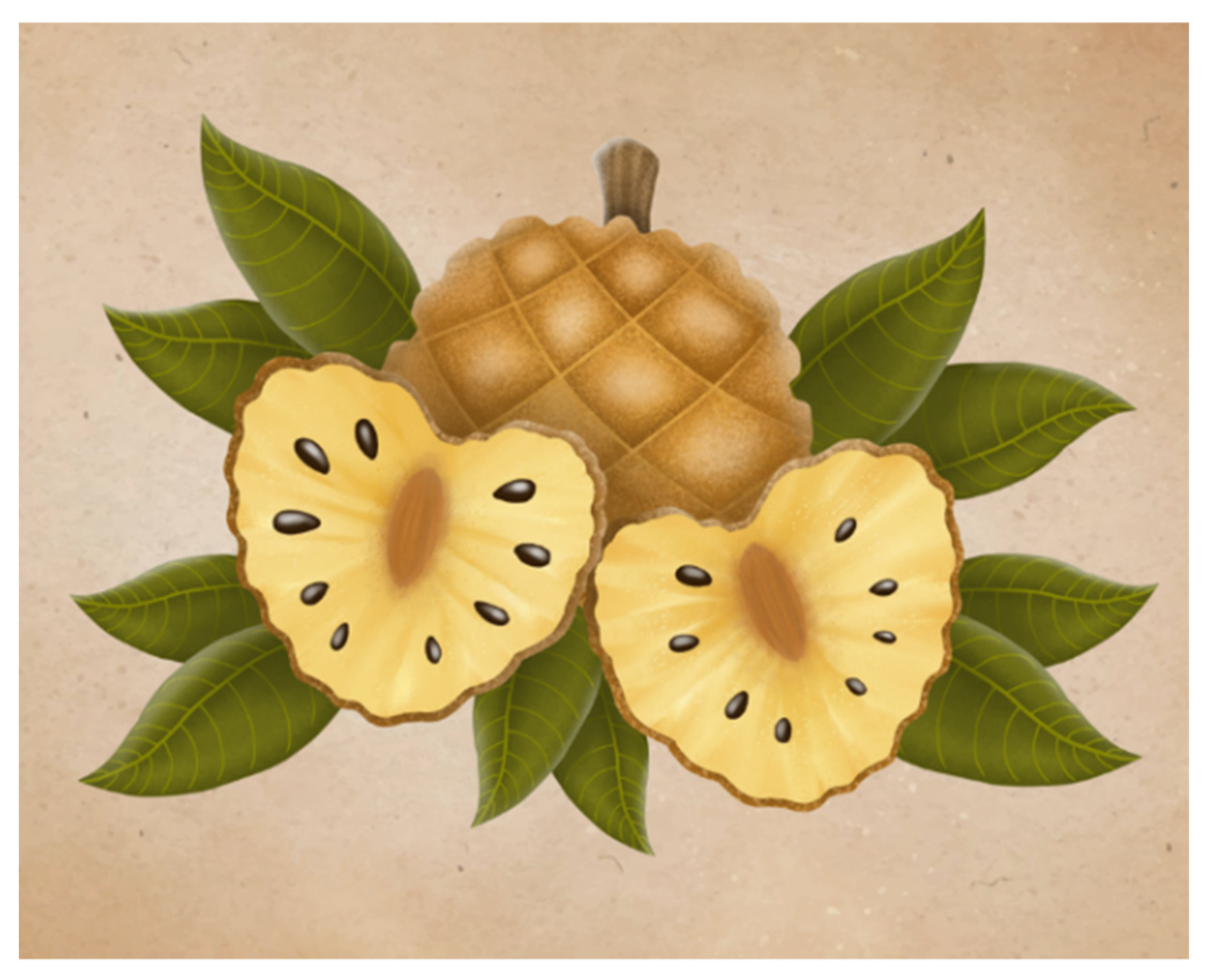
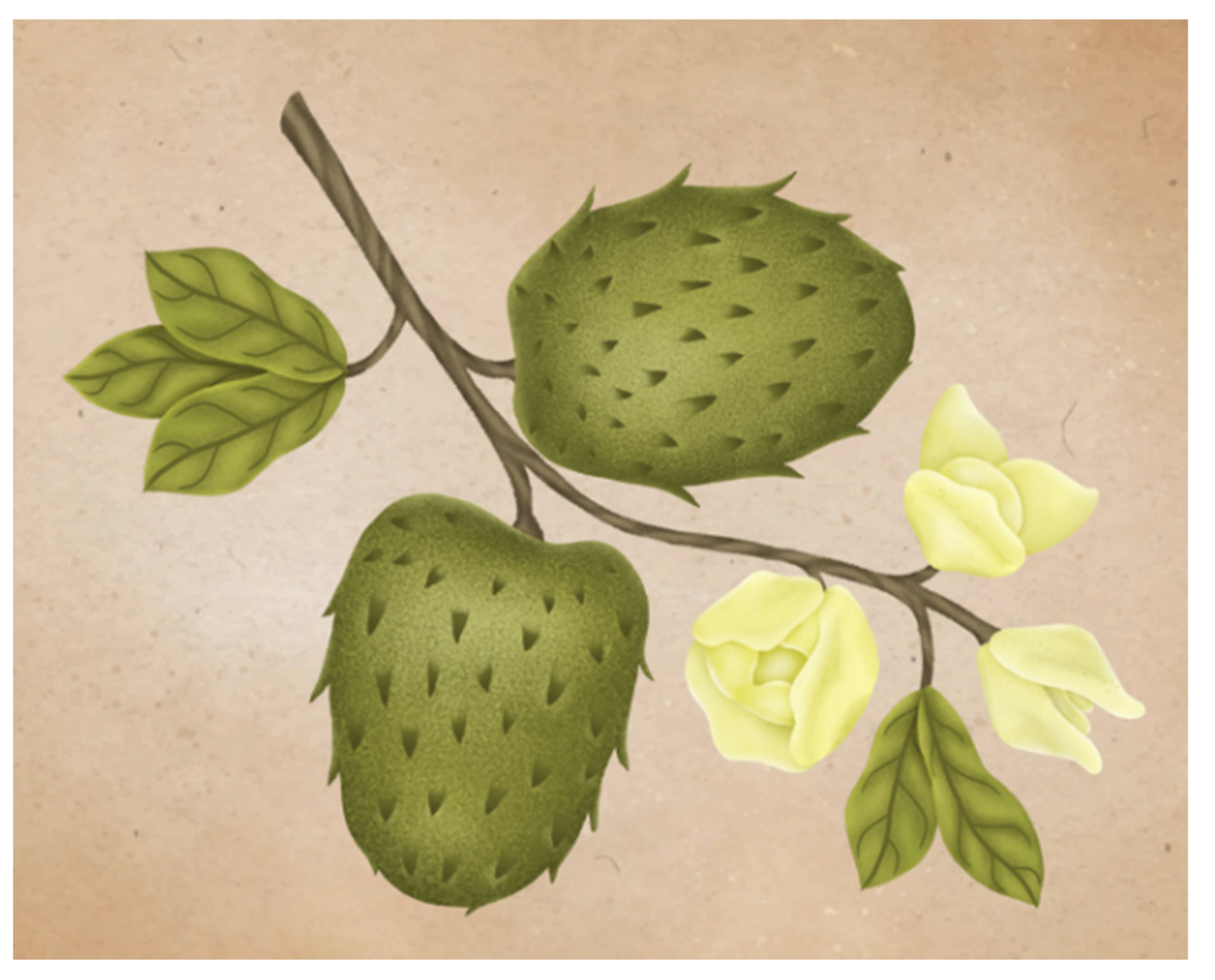
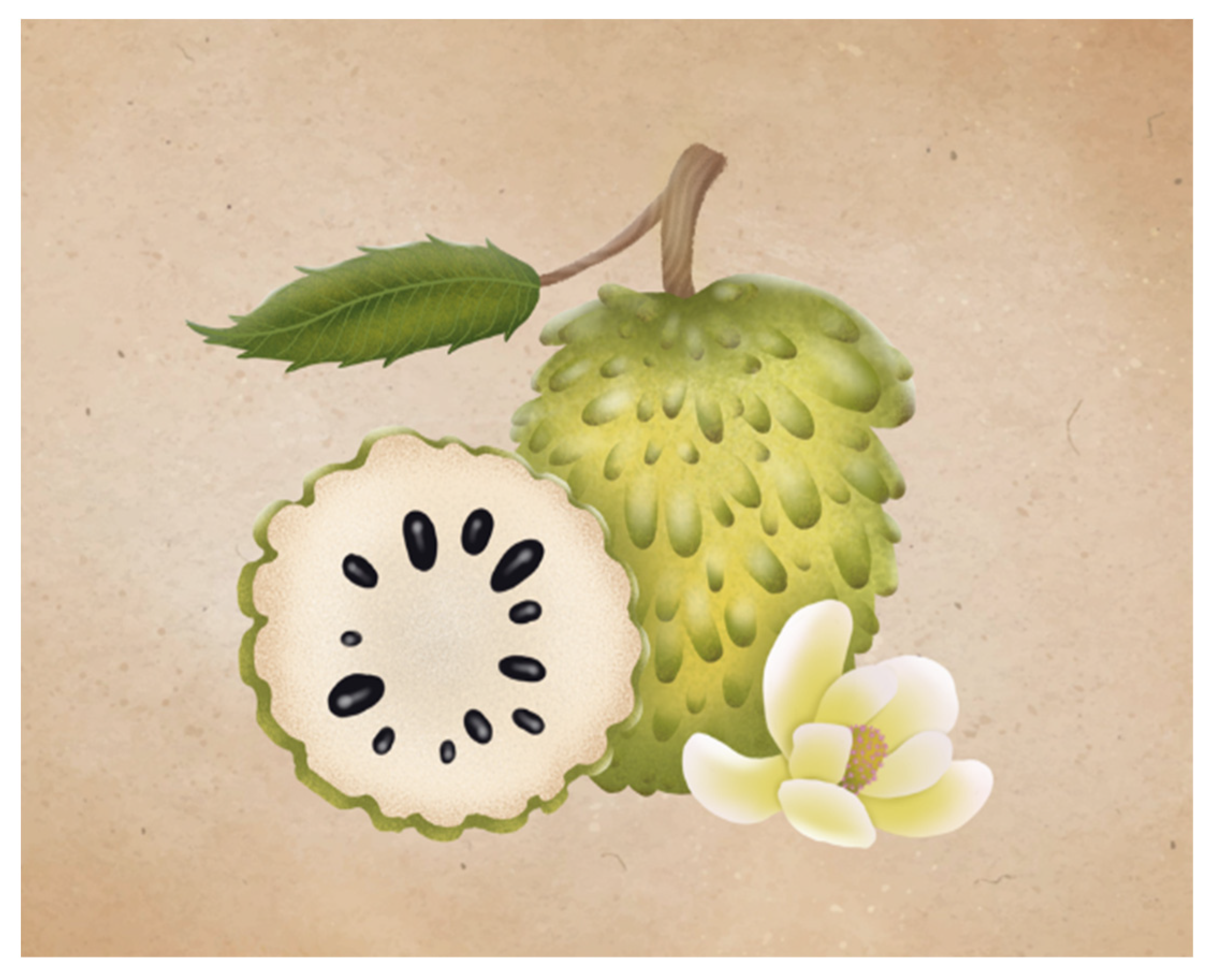
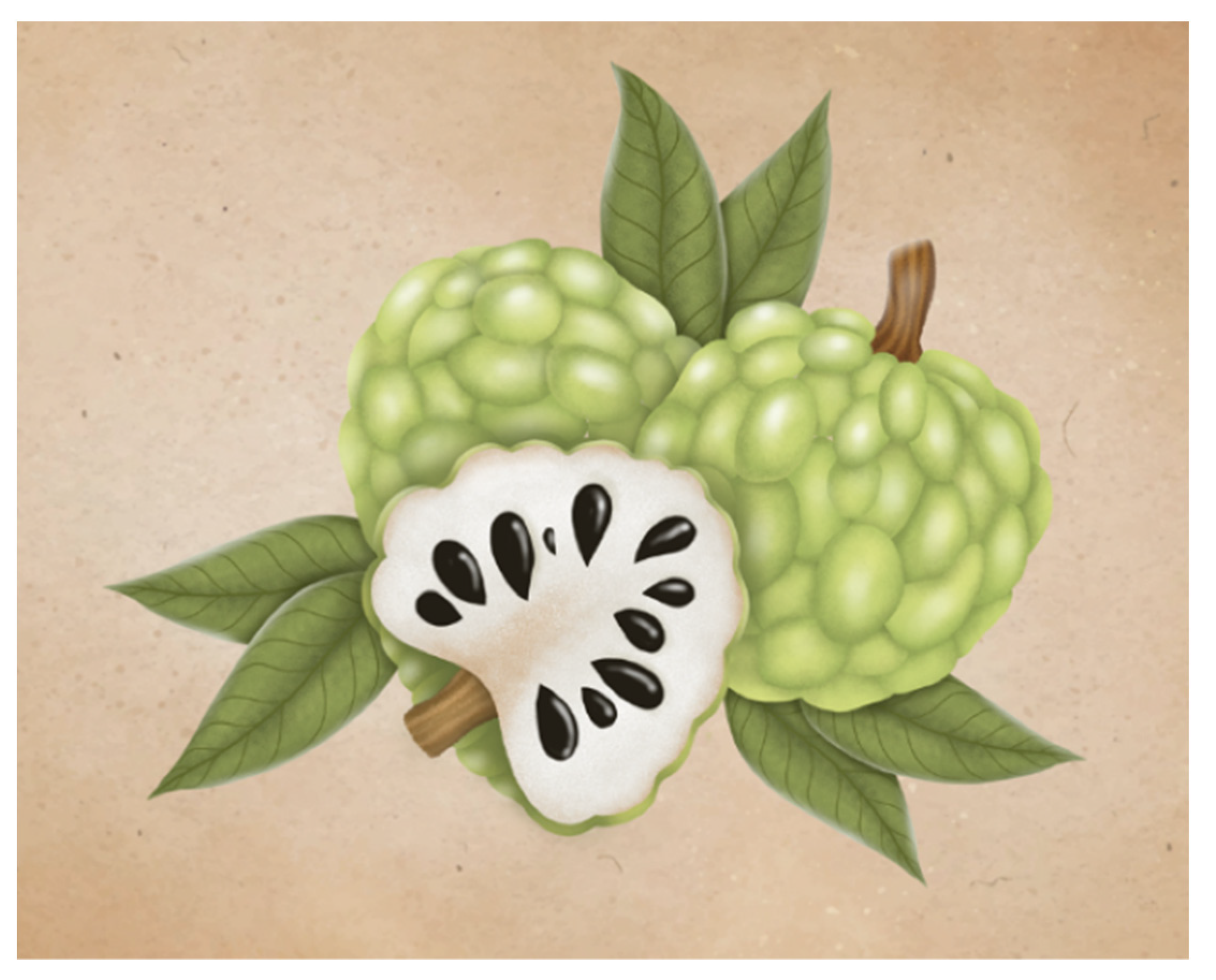
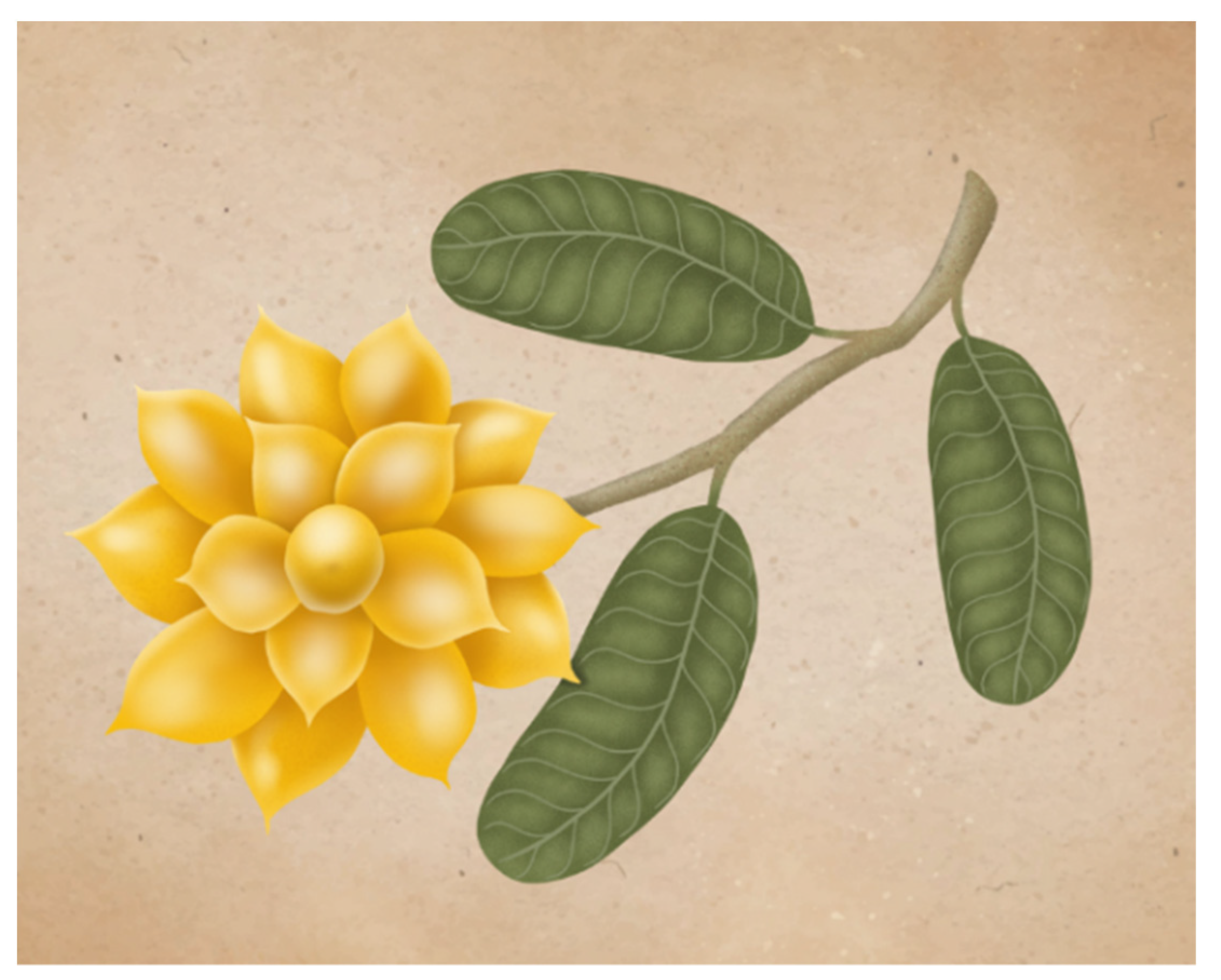
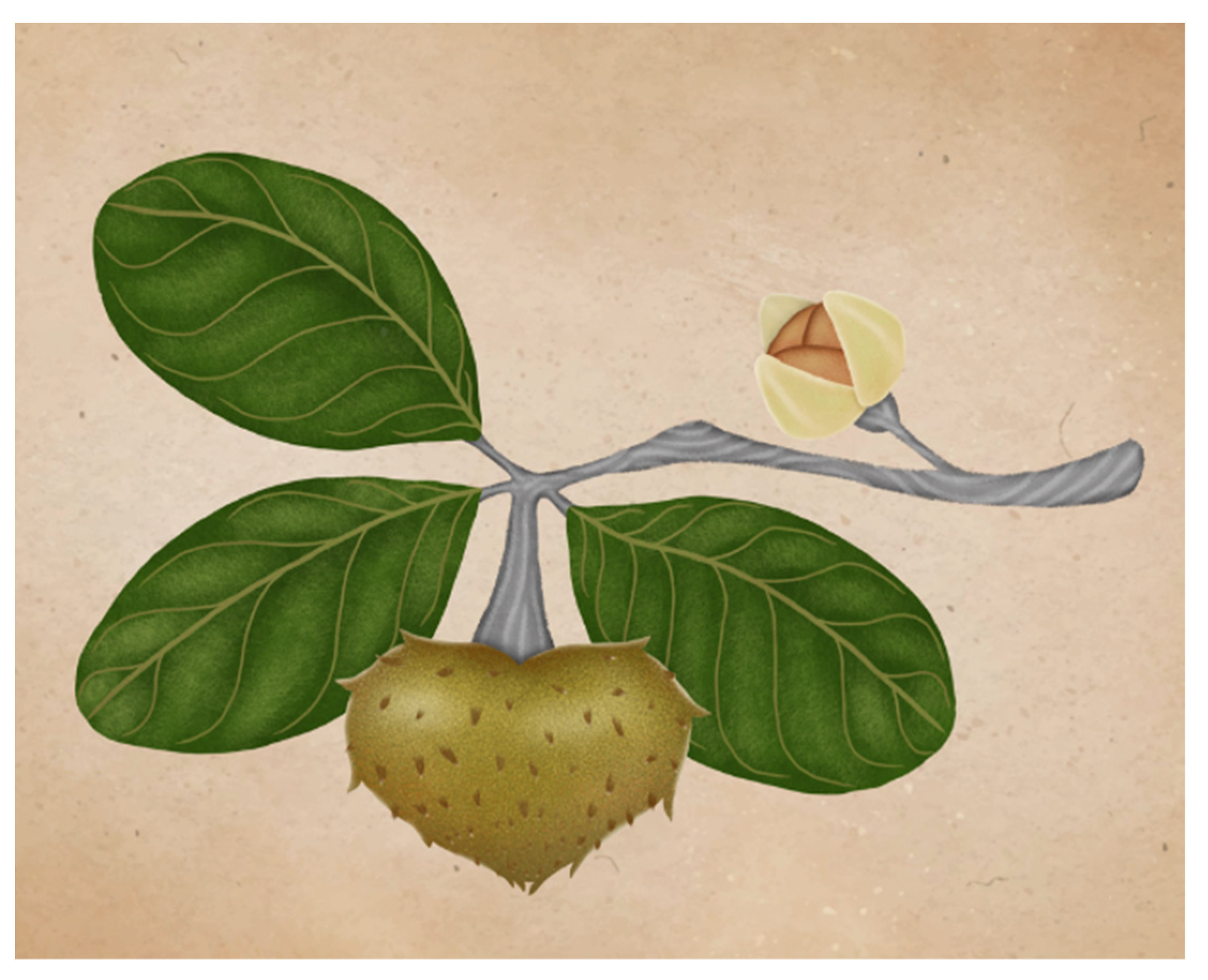
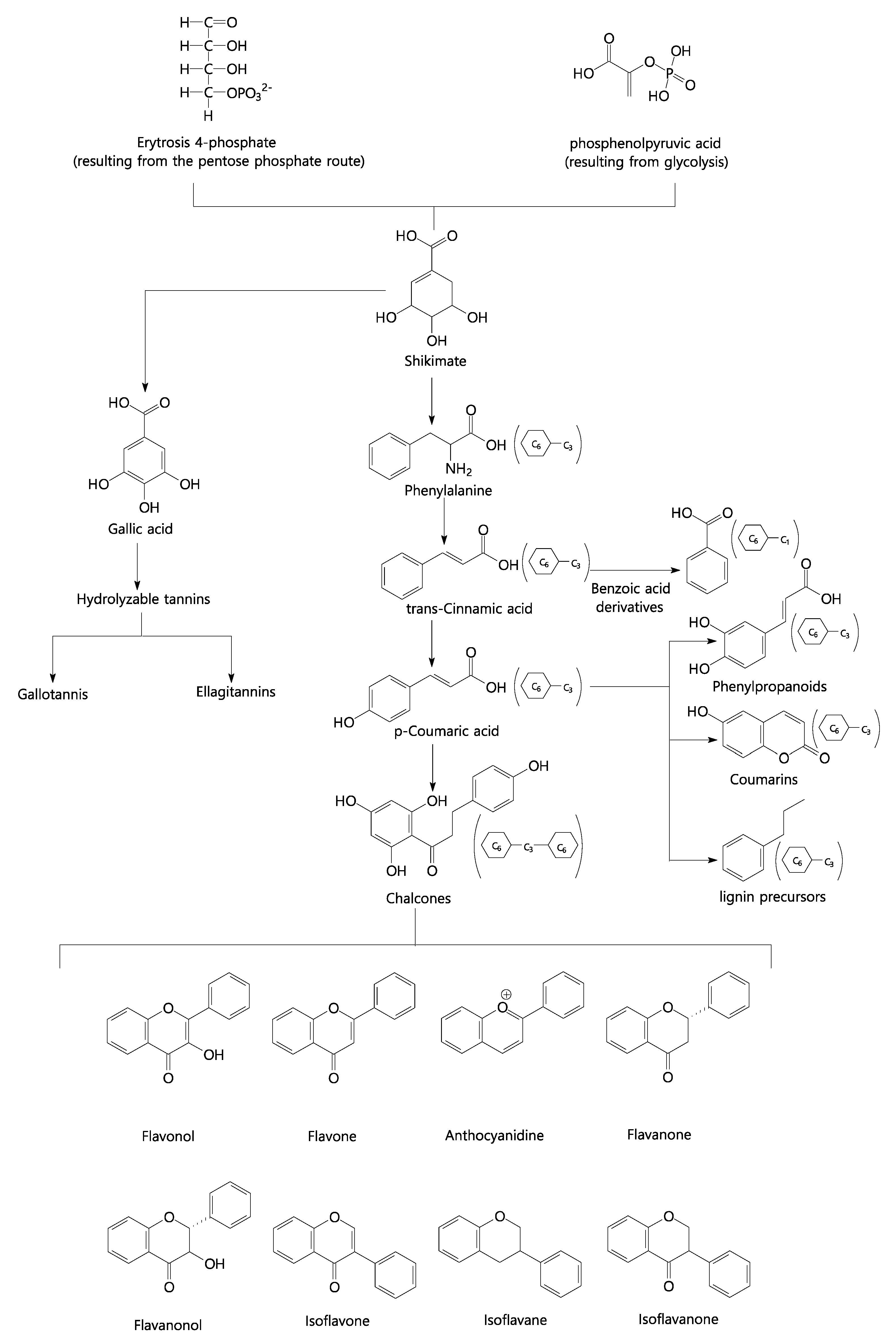


| Database | Number of Works | Duplicates | Total |
|---|---|---|---|
| Periódicos Capes | 63 | ||
| Scielo | 41 | 8 | 209 |
| Science Direct | 113 |
| Sample | What Was Done | Flavonoids Found | Reference |
|---|---|---|---|
| Peel extracts of araticum and seeds | This analysis was performed using an HPLC system coupled to a triple quadrupole mass spectrometer equipped with electrospray ionization (ESI). | Epicatechin and quercetin | [69] |
| Different botanical parts of araticum (fruit, leaves, stem, and root) | A review of the scientific literature was carried out on the main phytochemicals of different botanical parts of Annona crassiflora Mart. (fruits, leaves, stem, and root). | Catechin, epicatechin, rutin, quercetin | [24] |
| Araticum pulp, peel, and seed | The phenolics present in the araticum pulp, peel, and seed were characterized and quantified using HPLC-ESI-MS/MS. | Catechin, epicatechin, and caffeic acid | [26] |
| Peel of araticum | An HPLC-ESI-MS/MS analysis was performed to identify the main bioactive compounds of A. crassiflora fruit peel from ethanol extract fractions with antioxidant capacity and α-amylase, α-glucosidase, and glycosidase inhibitory activities. | Epicatechin, quercetin glucosides, and kaempferol | [70] |
| Different partos of marolinho | A search was carried out for scientific articles from electronic databases (Science Direct, PubMed, Lilacs, Scopus, Google Scholar, Scielo, and Web of Science), identifying studies published before November 2020. | Luteolin and quercetin | [21] |
| Peel of araticum | The effects of rated ultrasonic power (160–640 W) and process time (0.5–5.0 min) on the recovery of phenolic compounds and antioxidant activity of araticum peel were investigated. | Epicatechin, rutin, and catechin | [71] |
| Leaves of marolinho | The compounds were analyzed using traditional UV spectroscopy techniques and subjected to acid hydrolysis. The identity of eleven isolated compounds was established by 1H and 13 RNH spectra and compared with literature data. | Quercetin-3-O-β-(6″-O-β-glucosyl)-gloside (quercetin-3-O-gentiobioside); quercetin-3-O-β-(6″-O-α-rhamnosyl)-galactoside (quercetin-3-O-robinobioside); quercetin-3-O-β-(6″-O-α-rhamnosyl)-glucoside (rutin), quercetin-3-O-β-galactoside (hyperin), quercetin-3-O-β-glucoside (isoquercitrin); kaempferol-3-O-β-(6″-O-α-rhamnosyl)-galactoside (biorobin); kaempferol-3-O-β-(6″-O-α-rnoshamyl)-glucoside (nicotiflorin); isorhamnetin-3-O-β-(6″-O-α-rhamnosyl)-galactoside (chioside); isorhamnetin-3-O-β-(6″-O-α-rhamnosyl)-glucoside (narcissin); isorhamnetin-3-O-β-galactoside (cacticin); isorhamnetin-3-O-β-glucoside | [72] |
| Graviola and marolo seeds | Chemical composition was evaluated: approximate analysis, mineral profile, pectic substances, carbohydrates, fatty acid profile, and bioactive compounds of two main exotic fruit residues (seeds), marolo and graviola. | Rutin | [73] |
| Leaves of graviola | Ultrasound mechanical applicator-assisted extraction (UMSAE) of extraction yield, total alkaloid content (TAC), and antioxidant activity (DPPH) tests were performed. | Saponarin, epicatechin, rutin, kaempferol, glabridin, quercetin, and quercetin-3β-D-glucoside | [31] |
| Leaves of graviola | The identification of the main bioactive compounds of A. muricata leaves was performed by HPLC-ESI MS/MS. | Epicatechin, quercetin, quercetin-hexolate, and kaempferol | [74] |
| Leaves extract of graviola | The immune-boosting activity of graviola leaf extracts on RAW 264.7 macrophage cells was examined. The identification of compounds was through LC-MS/MS. | Kaempferol-3-O-rutinoside and quercetin-3-O-rutinoside | [75] |
| Different parts of graviola | The active components were evaluated using high-performance liquid chromatography (HPLC) to identify potential development as new functional products. | Rutin and epicatechin | [76] |
| Leaves of graviola | Flavonoids and phenolic compounds were identified and quantified by the high-performance liquid chromatography (HPLC) method. | Quercetin, isoquercitrin, quercitrin, rutin, and kaempferol | [77] |
| Leaves extract of graviola | The aqueous extract (AE) and acidified ethanolic extract (AEE) of graviola leaf were characterized by ultra-performance liquid chromatography (UPLC). | Rutin | [78] |
| Leaves of atemoya | To identify and quantify phenolic compounds in the samples, HPLC-DAD ESI-MS/MS was used. | Quercetin-3-O-rutinoside-7-O glycoside; quercetin-3-O-rutinoside-7-O-pentoside; quercetin-3-O-rutinoside; kaempferol 3-galactoside-7-rhamnoside; quercetin-3-O-glucoside; kaempferol-3-O-glucoside; luteolin-3-galactoside-7-rhamnos; luteolin-3-glucoside-7-rhamnose; apigenin-8-C-glucoside; catechin and epicatechin | [62] |
| Leaves of marolinho | The isolated compounds and their commercial aglycones were evaluated for DPPH, ABTS+- radical scavenging, ferric reducing antioxidant power (FRAP), and oxygen reducing antioxidant capacity (ORAC). | Quercetin-3-O-gentiobioside; quercetin-3-O-robinobioside; rutin; hyperin; isoquercitrin; biorobin; nicotiflorin; keioside; narcissin, cacticin, and isorhamnetin-3-O-glucoside | [79] |
| Database | Search Strategy | no of Works |
|---|---|---|
| Science Direct | flavonoid AND Araticum OR Annona crassiflora flavonoid AND Graviola OR Annona muricata flavonoid AND Atemoya OR A. squamosa × A. cherimola flavonoid AND Pinha OR Annona squamosa flavonoid AND Bananinha OR Annona leptopetala flavonoid AND Annona coriacea OR Marolinho | 1177 |
| Periódicos CAPES | Araticum OR Annona crassiflora AND flavonoid Graviola OR Annona muricata AND flavonoid Atemoya OR A. squamosa × A. cherimola AND flavonoid Pinha OR (Annona squamosa) AND flavonoid Bananinha OR Annona leptopetala AND flavonoid Annona coriacea OR Marolinho AND flavonoid | 1198 |
| Scielo | (Araticum) OR (Annona crassiflora) (Graviola) OR (Annona muricata) (Atemoya) OR (A. Squamosa × A. Cherimola) (Pinha) OR (Annona squamosa) (Bananinha) OR (Annona leptopetala) (Marolinho) OR (Annona coriacea) | 102 |
Publisher’s Note: MDPI stays neutral with regard to jurisdictional claims in published maps and institutional affiliations. |
© 2022 by the authors. Licensee MDPI, Basel, Switzerland. This article is an open access article distributed under the terms and conditions of the Creative Commons Attribution (CC BY) license (https://creativecommons.org/licenses/by/4.0/).
Share and Cite
Ramos, A.L.C.C.; Mazzinghy, A.C.d.C.; Correia, V.T.d.V.; Nunes, B.V.; Ribeiro, L.V.; Silva, V.D.M.; Weichert, R.F.; Paula, A.C.C.F.F.d.; Sousa, I.M.N.d.; Ferreira, R.M.d.S.B.; et al. An Integrative Approach to the Flavonoid Profile in Some Plants’ Parts of the Annona Genus. Plants 2022, 11, 2855. https://doi.org/10.3390/plants11212855
Ramos ALCC, Mazzinghy ACdC, Correia VTdV, Nunes BV, Ribeiro LV, Silva VDM, Weichert RF, Paula ACCFFd, Sousa IMNd, Ferreira RMdSB, et al. An Integrative Approach to the Flavonoid Profile in Some Plants’ Parts of the Annona Genus. Plants. 2022; 11(21):2855. https://doi.org/10.3390/plants11212855
Chicago/Turabian StyleRamos, Ana Luiza Coeli Cruz, Ana Carolina do Carmo Mazzinghy, Vinícius Tadeu da Veiga Correia, Bruna Vieira Nunes, Lucas Victor Ribeiro, Viviane Dias Medeiros Silva, Reginaldo Ferreira Weichert, Ana Cardoso Clemente Filha Ferreira de Paula, Isabel Maria Nunes de Sousa, Ricardo Manuel de Seixas Boavida Ferreira, and et al. 2022. "An Integrative Approach to the Flavonoid Profile in Some Plants’ Parts of the Annona Genus" Plants 11, no. 21: 2855. https://doi.org/10.3390/plants11212855
APA StyleRamos, A. L. C. C., Mazzinghy, A. C. d. C., Correia, V. T. d. V., Nunes, B. V., Ribeiro, L. V., Silva, V. D. M., Weichert, R. F., Paula, A. C. C. F. F. d., Sousa, I. M. N. d., Ferreira, R. M. d. S. B., Batista-Santos, P., Araújo, R. L. B. d., & Melo, J. O. F. (2022). An Integrative Approach to the Flavonoid Profile in Some Plants’ Parts of the Annona Genus. Plants, 11(21), 2855. https://doi.org/10.3390/plants11212855








